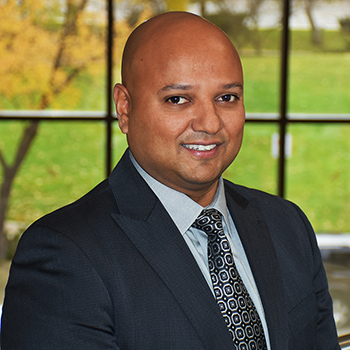Message from Lloyd Noronha, Vice-President: Finance and Administration
Sustainability at Laurier is positioned within the Finance and Administration portfolio to readily allow the integration of sustainability initiatives into all operational areas within the university. My portfolio includes financial resources, procurement, information and communication technology, facilities and asset management, internal audit, insurance and risk management, community safety and security, and ancillary services. Integration of sustainability initiatives and opportunities are readily established through my portfolio and beyond.
Laurier is committed to raising awareness and inspiring action to create a more sustainable future in line with the Laurier Strategy 2019-2024. This encourages our community to lead in environmental sustainability at all our campuses and inspire the incorporation of sustainable practices in society and the economy. Consultation within our Laurier community and with external stakeholder partners of the Sustainability Office has been integral in identifying unique opportunities to explore within the 2023-2028 Sustainability Action Plan.
Through projects that span operations, education and community partnerships, our goal is to create a culture where sustainability is embedded into university life. We look to inspire, educate, and equip our community to engage in initiatives that support a sustainable future. Laurier plays a critical role in preparing the next generation of leaders who will contribute to the achievement of the 2030 United Nations Sustainable Development Goals (SDGs) by advancing awareness and actions on campus and within the community.
We are proud of the sustainability success stories at Laurier, including our Laurier Energy Efficiency Program (LEEP) completed in 2022, which was a $48 million capital retrofit project resulting in two solar thermal walls, 15,000 LED light replacements, 1,300 low-flow water fixtures, and a microgrid system with a six-megawatt battery storage system. Our leadership has also elected to sign the Investing to Address Climate Change: A Charter for Canadian Universities, resulting in a 40% reduction in carbon intensity in our endowment fund with plans for further reductions and the long-term development of a fossil-free endowment fund.
The next five years are critical for Laurier to achieve behaviour change within the Laurier community and capital infrastructure upgrades to be able to reach our greenhouse emissions reduction mandate of 40% by 2030 and carbon neutrality by 2050. Key themes of the 2023-2028 Sustainability Action Plan include human and ecosystem health and well-being, climate action and social sustainability. The focus of the plan is to continue to support the culture of sustainability at Laurier through academics, research, physical operations, outreach, and community partnerships to achieve sustainability goals.
The pursuit of sustainability is an ongoing and collective effort. I would like to thank the many students, staff, faculty, and alumni from across the Laurier community who have worked hard to develop our 2023-2028 Sustainability Action Plan. It is a clear and progressive strategy that will help Laurier continue to lead by example amongst academic institutions in Ontario and the rest of Canada.











